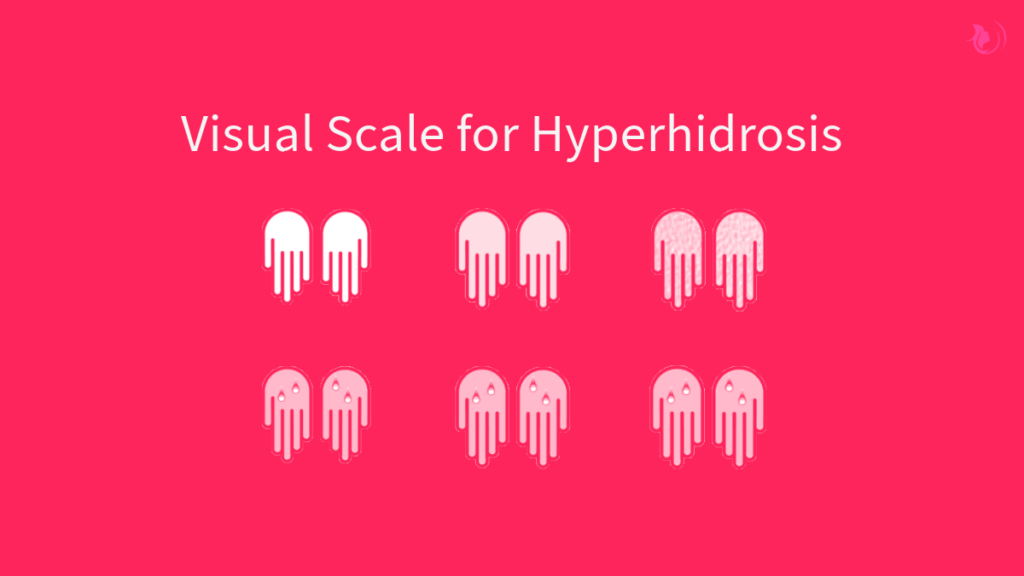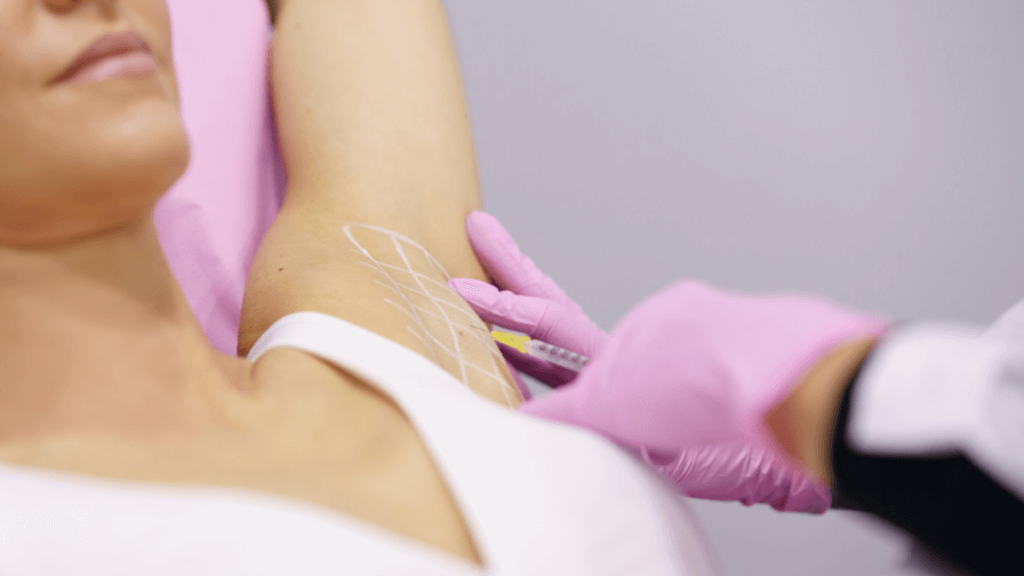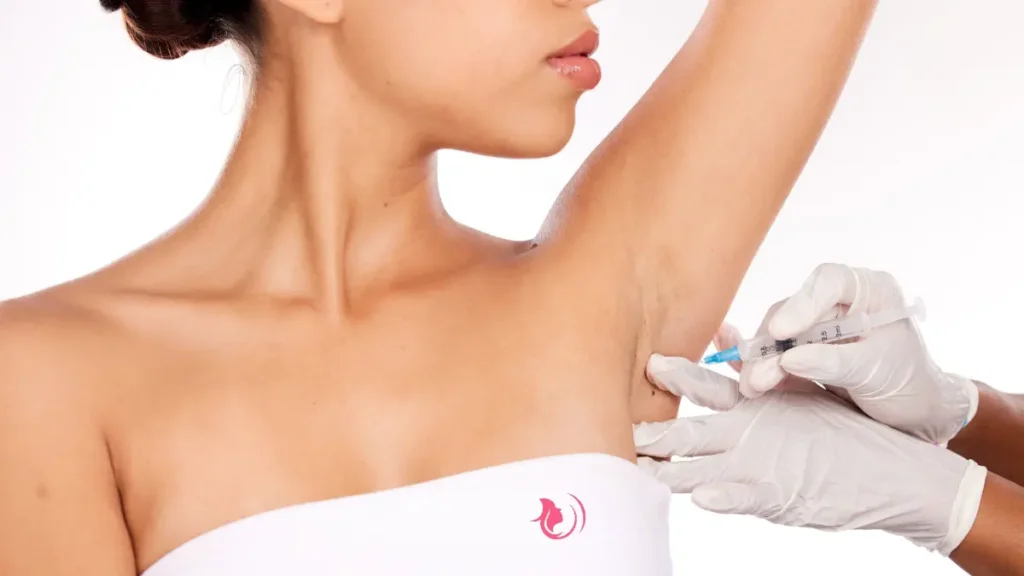Hyperhidrosis or excessive sweating is considered a socially awkward condition. And it really is. It is a health condition wherein a person exhibits excessive sweating in the armpit area even though the location is not necessarily hot. It is a condition that could easily cause discomfort not only for the patient but also for those around them.
Fortunately, different solutions were discovered to easily deal with hyperhidrosis. One of the increasingly popular solutions for excessive swearing is Botox or Botulinum Toxin. Although Botox is primarily known as a method of preventing wrinkles in the skin, it has also exhibited behaviours that assist people suffering from hyperhidrosis.
What is Hyperhidrosis
At its core, hyperhidrosis is indeed about those overzealous nerves in the armpit area, but let’s break it down in a bit more detail for a clearer picture. So, imagine your body’s sweat production like a tap controlled by the nervous system. In most people, this tap turns on and off in response to things like heat or exercise. However, for those with hyperhidrosis, it’s as if the tap is stuck in the ‘on’ position, especially in areas like the armpits.
The nerves responsible for sweating, primarily the sympathetic nervous system, get a bit overexcited. They send constant, over-the-top signals to the sweat glands, essentially saying, “Let’s keep the party going!” And the sweat glands, being the obedient partygoers they are, keep pumping out sweat.
But here’s the kicker: this happens even when the body doesn’t need cooling. People with hyperhidrosis might be sitting cool as a cucumber, yet their armpits are throwing a sweat rave. It’s like having a mind of their own, independent of the body’s actual temperature or physical activity needs.
This condition isn’t just a bit of extra perspiration. It can be quite impactful, affecting social interactions, clothing choices, and overall comfort. But the good news? There are treatments available, ranging from strong antiperspirants to more advanced options like Botox or even surgery for severe cases.
So, in summary, hyperhidrosis is like having an overenthusiastic nerve-sweat gland team in the armpits, going all out on sweat production without a real need. It’s a bit more complex than just nerves controlling sweat, but you’ve got the gist of it!
Little-Known Facts

Primary vs. Secondary Hyperhidrosis: Hyperhidrosis can be classified into two types: primary and secondary. Primary hyperhidrosis occurs without any underlying medical condition and is often localised to areas such as the hands, feet, and underarms. In contrast, secondary hyperhidrosis is linked to another medical issue, such as thyroid disorders, diabetes, or medication side effects, and can affect more widespread areas like the head, chest, or back.
Emotional Triggers: Emotional factors like stress, anxiety, or fear can significantly exacerbate hyperhidrosis. This phenomenon, often referred to as “emotional sweating,” highlights the strong connection between the nervous system and sweat glands. Even mild stressors can trigger excessive sweating, making social interactions or stressful situations particularly challenging for those affected.
Sleep Interference: Excessive sweating isn’t just a daytime problem—it can also disrupt sleep. Night sweats can lead to discomfort, frequent waking, and even insomnia, resulting in fatigue, irritability, and diminished overall quality of life. This aspect of hyperhidrosis is often overlooked but can be particularly debilitating for sufferers.
Genetic Predisposition: There is a notable genetic component to primary hyperhidrosis, with the condition often running in families. Studies suggest that if one parent has hyperhidrosis, their child has a higher chance of developing it as well, highlighting the hereditary nature of the disorder.
Age-Related Changes: The severity of hyperhidrosis can change over time, and in some individuals, it may improve or even diminish with age. Hormonal changes, lifestyle adjustments, or the natural ageing process can all influence the condition, leading to fluctuations in sweating patterns.
Botox in Relation to Hyperhidrosis

Botox, or Botulinum toxin, is widely known for its cosmetic applications, but it’s also a bit of a star in the medical world for conditions like hyperhidrosis. The way it works for excessive sweating is pretty intriguing.
Picture Botox as a bit of a gatecrasher at the nerve-sweat gland party I mentioned earlier. When injected into the armpits, Botox doesn’t exactly freeze the nerves, but it does something equally clever. It blocks the chemical signals from the nerves that stimulate the sweat glands. Essentially, it’s telling the nerves, “Take a break, lads. No more messages to the sweat glands, please!”
This blockade is why people with hyperhidrosis find relief after Botox injections. The sweat glands don’t get the ‘let’s sweat’ memo from the nerves, so they stop producing excess sweat. It’s like cutting the phone line in our metaphorical party scenario.
The procedure itself is indeed relatively simple. A doctor will use a very fine needle to inject Botox directly into the armpit area. It’s not just a one-shot deal, though. The treatment involves multiple small injections around the armpit to ensure the Botox is evenly distributed.
Now, while it’s straightforward, it’s important to remember that this is still a medical procedure. It should be done by a qualified professional who understands the intricacies of Botox and its effects on the body. Safety first, after all!
The effects of Botox for hyperhidrosis are not permanent; they typically last about 6 to 12 months. So, it’s more of a temporary pause than a permanent off switch for sweating. After that, the nerves start chatting with the sweat glands again, and the treatment may need to be repeated.
Botox for hyperhidrosis works by disrupting the communication between nerves and sweat glands in the armpits. It’s a clever use of a substance more commonly associated with smoothing wrinkles, showing just how versatile and effective Botox can be in the right hands!
Temporary but Effective Solution
Botox is not permanent. Think of it like putting a temporary pause on the sweat glands’ activities. Over time, the effects of Botox gradually diminish. This happens because the nerve endings eventually regenerate and resume sending signals to the sweat glands. It’s as if the nerves say, “Alright, break’s over, back to work!”
Now, regarding the frequency of treatments – this is a bit like tailoring a suit; it’s highly individual. On average, a person might need Botox injections for hyperhidrosis about every 6 to 12 months. However, this can vary widely depending on how each individual’s body reacts to the treatment. Some lucky folks might find their armpits staying dry for a bit longer, while others may need a top-up sooner.
The beauty of Botox in this context is its adaptability. Treatment schedules can be adjusted based on how each person’s body responds and when the symptoms of hyperhidrosis begin to creep back. It’s a bit like setting a reminder for a regular check-up – “Is it time for another round?” – but based on your body’s cues rather than the calendar.
It’s also worth noting that Botox treatments for hyperhidrosis are generally well-received, with many patients reporting significant improvement in their quality of life. Imagine being able to wear that silk shirt or raise your hand without a second thought about sweat marks – that’s the kind of change we’re talking about!
In summary, Botox for hyperhidrosis is indeed a temporary solution, but its relatively infrequent application (typically twice a year, give or take) makes it a manageable and popular option for those seeking relief from excessive underarm sweating. It’s all about finding that sweet spot in timing that works best for each individual.



1 Comment
As someone who’s battled with hyperhidrosis, I’ve tried various treatments, but Botox never crossed my mind. The way it disrupts the communication between nerves and sweat glands makes so much sense. I appreciate the detailed explanation, and I’m seriously considering giving it a try to see if it helps me regain some control over this condition.